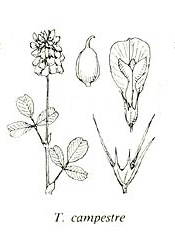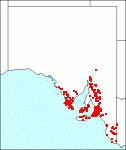Family: Fabaceae
Trifolium campestre
Citation:
Schreber in Sturm, Deutschl. Fl. 1, 16:13 (1804).
Synonymy: T. procumbens L. sensu J. Black, Fl. S. Aust. 452 (1948), ?non L.
Common name: Hop clover.
Description:
Glabrous or pubescent annual; stems ascending or prostrate, 4-50 cm long; leaflets rhombic or obovate, 8-16 mm long, cuneate, denticulate, the terminal one petiolulate; stipules semi-ovate, dilated and rounded at the base, shorter than the petiole.
Flowers 20-50, in distinctly pedunculate dense ovoid heads, 8-15 mm wide, on pedicels half as long as the calyx tube, at first erect, soon deflexing; calyx glabrous or rarely slightly hairy, 1.5-2 mm long; teeth unequal, the upper 2 shortest, as long as or shorter than the upper limb of the calyx tube, lower teeth 1 or 2 times as long as the lower part of the tube; corolla 4-7 mm long, yellow; standard very broad, obovate, lined with furrows, finally recurved over the shorter divergent wings and obtuse keel, not folded.
Pod ellipsoid, scarious, 1-seeded; seed ovoid, 1-1.2 mm long, yellow, smooth.

|
|
Image source: fig. 353C in Jessop J.P. & Toelken H.R. (Ed.) 1986. Flora of South Australia (4th edn).
|
Published illustration:
Cunningham et al. (1982) Plants of western New South Wales, p. 425.
|
|
Distribution:
|
S.Aust.: FR, EP, NL, MU, YP, SL, KI, SE. all States. New Zealand; native to Europe, the Mediterranean region and western Asia.
|
Conservation status:
naturalised
Flowering time: Sept. — Dec.
|

SA Distribution Map based
on current data relating to
specimens held in the
State Herbarium of South Australia
|
Biology:
No text
Taxonomic notes:
Differs slightly from T. dubium in the many-flowered (often more than 30) oblong heads and in the standard which (in fruiting heads) becomes slightly enlarged and broadened into a striate spoon-shaped portion hooded over the pod and other petals.
Author:
Not yet available
|

